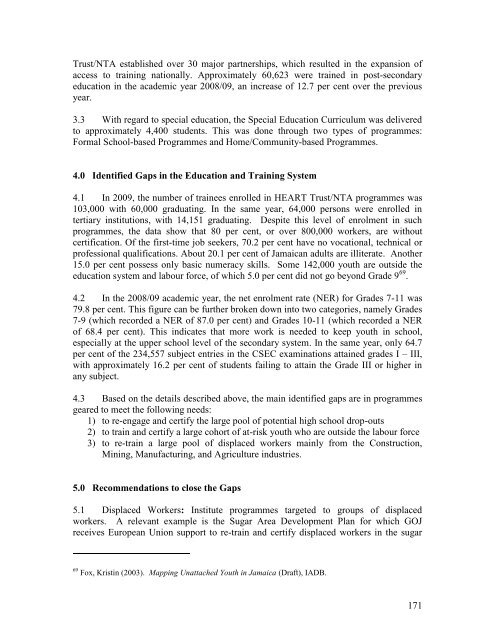PIOJ Growth-Inducement Strategy - Planning Institute of Jamaica
PIOJ Growth-Inducement Strategy - Planning Institute of Jamaica
PIOJ Growth-Inducement Strategy - Planning Institute of Jamaica
You also want an ePaper? Increase the reach of your titles
YUMPU automatically turns print PDFs into web optimized ePapers that Google loves.
Trust/NTA established over 30 major partnerships, which resulted in the expansion <strong>of</strong><br />
access to training nationally. Approximately 60,623 were trained in post-secondary<br />
education in the academic year 2008/09, an increase <strong>of</strong> 12.7 per cent over the previous<br />
year.<br />
3.3 With regard to special education, the Special Education Curriculum was delivered<br />
to approximately 4,400 students. This was done through two types <strong>of</strong> programmes:<br />
Formal School-based Programmes and Home/Community-based Programmes.<br />
4.0 Identified Gaps in the Education and Training System<br />
4.1 In 2009, the number <strong>of</strong> trainees enrolled in HEART Trust/NTA programmes was<br />
103,000 with 60,000 graduating. In the same year, 64,000 persons were enrolled in<br />
tertiary institutions, with 14,151 graduating. Despite this level <strong>of</strong> enrolment in such<br />
programmes, the data show that 80 per cent, or over 800,000 workers, are without<br />
certification. Of the first-time job seekers, 70.2 per cent have no vocational, technical or<br />
pr<strong>of</strong>essional qualifications. About 20.1 per cent <strong>of</strong> <strong>Jamaica</strong>n adults are illiterate. Another<br />
15.0 per cent possess only basic numeracy skills. Some 142,000 youth are outside the<br />
education system and labour force, <strong>of</strong> which 5.0 per cent did not go beyond Grade 9 69 .<br />
4.2 In the 2008/09 academic year, the net enrolment rate (NER) for Grades 7-11 was<br />
79.8 per cent. This figure can be further broken down into two categories, namely Grades<br />
7-9 (which recorded a NER <strong>of</strong> 87.0 per cent) and Grades 10-11 (which recorded a NER<br />
<strong>of</strong> 68.4 per cent). This indicates that more work is needed to keep youth in school,<br />
especially at the upper school level <strong>of</strong> the secondary system. In the same year, only 64.7<br />
per cent <strong>of</strong> the 234,557 subject entries in the CSEC examinations attained grades I – III,<br />
with approximately 16.2 per cent <strong>of</strong> students failing to attain the Grade III or higher in<br />
any subject.<br />
4.3 Based on the details described above, the main identified gaps are in programmes<br />
geared to meet the following needs:<br />
1) to re-engage and certify the large pool <strong>of</strong> potential high school drop-outs<br />
2) to train and certify a large cohort <strong>of</strong> at-risk youth who are outside the labour force<br />
3) to re-train a large pool <strong>of</strong> displaced workers mainly from the Construction,<br />
Mining, Manufacturing, and Agriculture industries.<br />
5.0 Recommendations to close the Gaps<br />
5.1 Displaced Workers: <strong>Institute</strong> programmes targeted to groups <strong>of</strong> displaced<br />
workers. A relevant example is the Sugar Area Development Plan for which GOJ<br />
receives European Union support to re-train and certify displaced workers in the sugar<br />
69 Fox, Kristin (2003). Mapping Unattached Youth in <strong>Jamaica</strong> (Draft), IADB.<br />
171
















